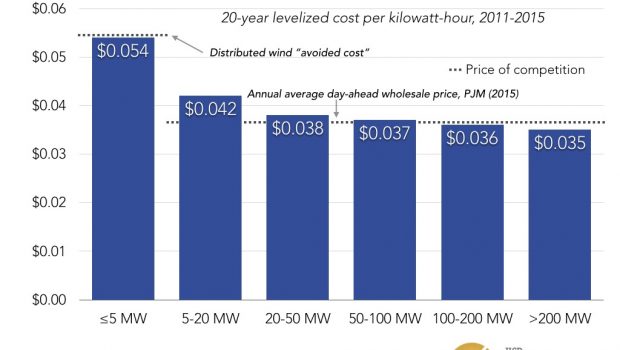Why it’s short-sighted to do centralized planning in a decentralizing electricity grid
Why it’s short-sighted to do centralized planning in a decentralizing electricity grid
Originally published at ILSR.org
With financial rewards tied to building big things, and a 100-year history of doing so, utilities overlook distributed energy resources like rooftop solar. State regulators, expecting the grid future to unfold from a utility’s central plan, rarely push back. But the truth is that central planning may cost everyone (except utility shareholders) more, because the most cost-effective electricity system can be built from the bottom up.
This essay formed the basis of comments ILSR filed regarding DTE’s 2020 Renewable Energy Plan in Michigan, but its implications strike at the heart of utility resource planning in all 50 states.
Why bigger isn’t best
What size of renewable energy costs less, large or small? If you try to answer this question, you may have been fooled, because the truth is that large-scale renewable energy competes in a different market than small-scale renewable energy. A report published by the Institute for Local Self-Reliance in 2016 and re-released in 2019 reveals the data that undercuts the persistent myth of big being better, particularly because the point of grid interconnection and proximity to load matter. The following chart from the report, “Wind Economies of Scale,” compares the levelized cost of wind power projects at different scales (based on 2011-2015 project data). Most projects larger than 5 megawatts will interconnect to the transmission system and compete with other wholesale producers. In this market, greater size does matter. But at the smallest scale, where size would appear as a disadvantage, projects can receive higher prices for displacing transmission losses and providing supply to meet the growing load on the distribution system. The distributed wind avoided cost figure came from contracts secured by a community wind developer in Minnesota.
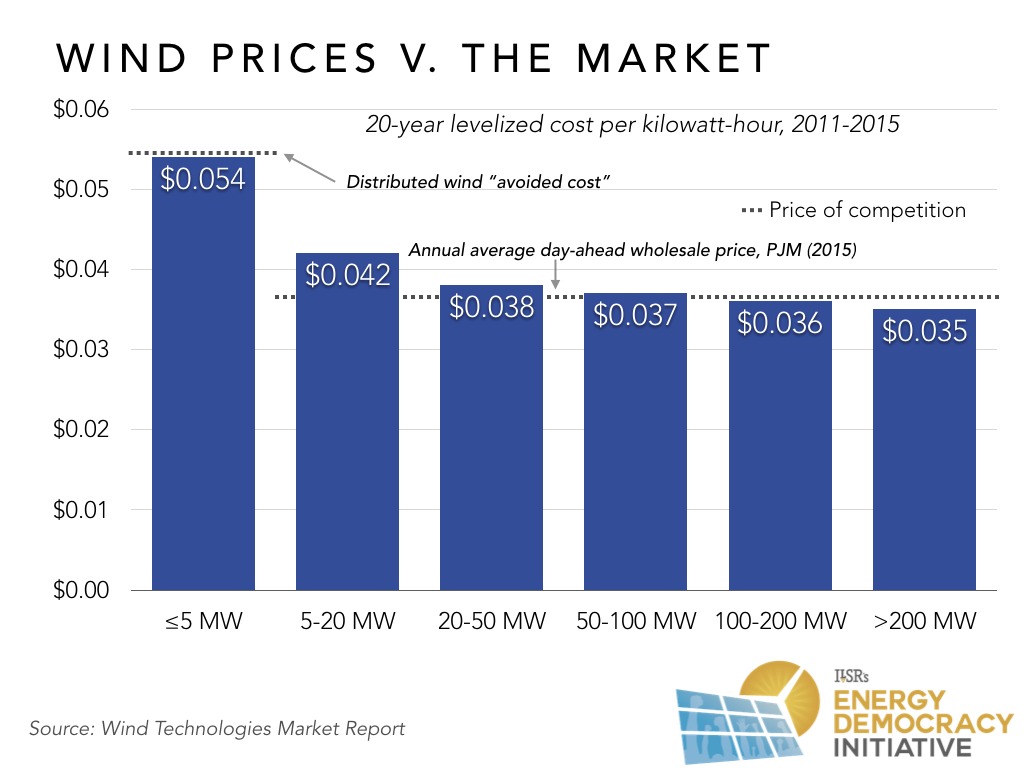
Solar projects have a similar dynamic, where the price of the competition isn’t the same. On-site projects compete with delivery costs of retail electricity, which includes generation, transmission, and distribution. Large-scale solar projects are among the least cost-effective in comparison, because their transmission interconnection costs swamp any marginal economies of scale. The following graphic, “Solar Competes at Most Sizes,” also from the Is Bigger Best report, illustrates several facts. First, on-site, small-scale solar competes against different prices than utility-scale solar. Second, the levelized cost of electricity production for solar projects between five and 20 MW are lower than larger solar projects, and the cost of delivered power from projects at those smaller sizes is even better due to the ability of those projects to inject power without expensive new transmission infrastructure. In other words, solar acquisition plans that ignore solar projects sized one to 20 megawatts may miss the most cost-effective solar project size segment.
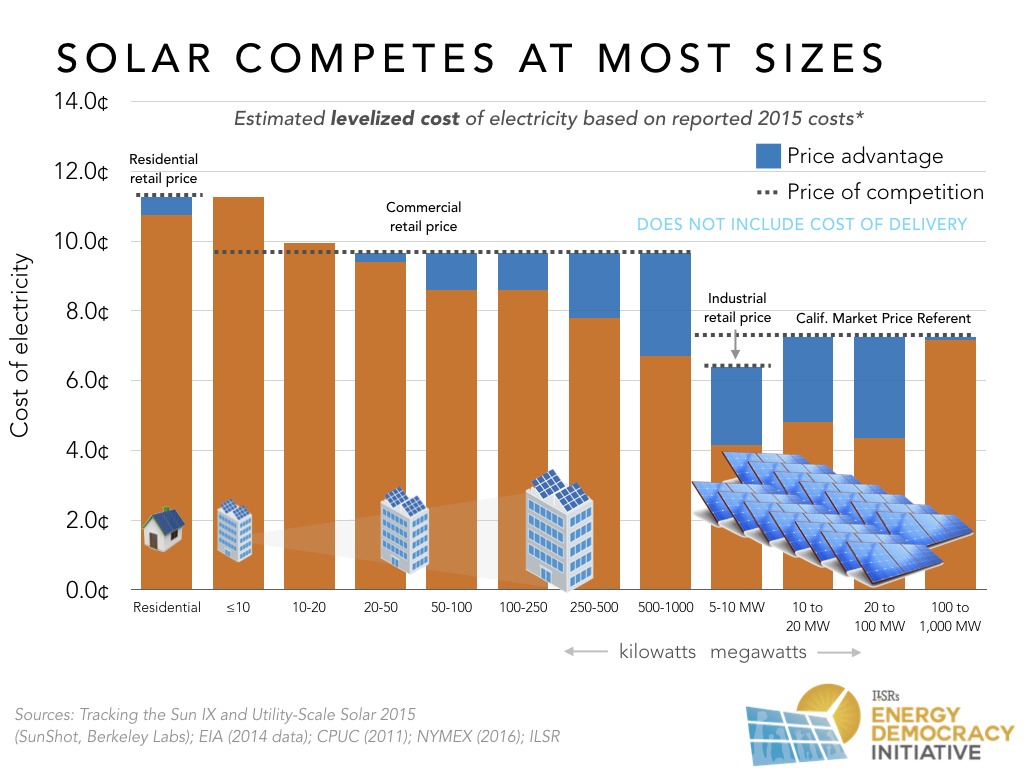
In fact, the perpetuation of the bigger is best myth has more to do with the perfectly rational financial interests of utility companies. Most vertically integrated monopoly utilities (or even those with just a distribution monopoly) earn a profit on capital expenditures. This means that large-scale power projects, especially if utility-owned, generate shareholder returns. In contrast, distributed energy projects are often not utility-owned but may also reduce the need for new capital expenditures by reducing infrastructure needs through provision of local capacity and energy. The following chart, from a 2014 study by the National Renewable Energy Laboratory, illustrates how utility management and shareholder interests differ from customer interests. The chart shows customer rate and shareholder return impacts for two different utilities in a hypothetical scenario of 10% of sales offset by customer-owned solar. In this model, customer electricity bills increase by 2.5% and 2.7% for the two utilities, respectively, but utility equity returns decrease by 3% and 8%, respectively. Where distributed solar is concerned, utility shareholders have much more to lose than customers. The unequal impact of widespread distributed solar penetration creates a conflict of interest for utility management because their monopoly license comes with an agreement to maximize the public interest.

Big savings from distributed energy
While monopoly utilities have a vested interest in downplaying distributed energy, public regulators have a vested interest in considering it for the consumer benefits. The Minnesota Smarter Grid Study provides a potent illustration of the importance of evaluating distributed and utility-scale means for future power generation.
Published in 2018, the study modeled the capacity and energy (in hourly increments) required to meet Minnesota’s grid demands with increasingly low-carbon energy. The study found massive savings for Minnesota’s electric customers in several scenarios reducing greenhouse gas emissions by 80% by 2050.
The study also shows that widespread distributed solar adoption is feasible and economically rewarding. In a state that’s nearing 1 gigawatt of installed distributed energy resources, the study showed that a thirteen-fold increase in distributed solar by 2050––including approximately 5 gigawatts by the mid-2030s––results in similar financial savings for all customers as statewide decarbonization scenarios that focus solely on utility-scale solar. The local solar scenario creates over 40,000 jobs and would provide billions of dollars in customer energy bill savings.
The following charts illustrate the opportunity. The first shows the quantity of installed rooftop solar in Minnesota through 2050 in the Vibrant Clean Energy Smarter Grid model. Most scenarios show 500 to 1,000 megawatts of rooftop solar PV deployment. The Local Decarbonization scenario shows 13,000 megawatts, or 13 gigawatts.
The Smarter Grid Study 13-Gigawatt Rooftop Solar Local Decarbonization Scenario
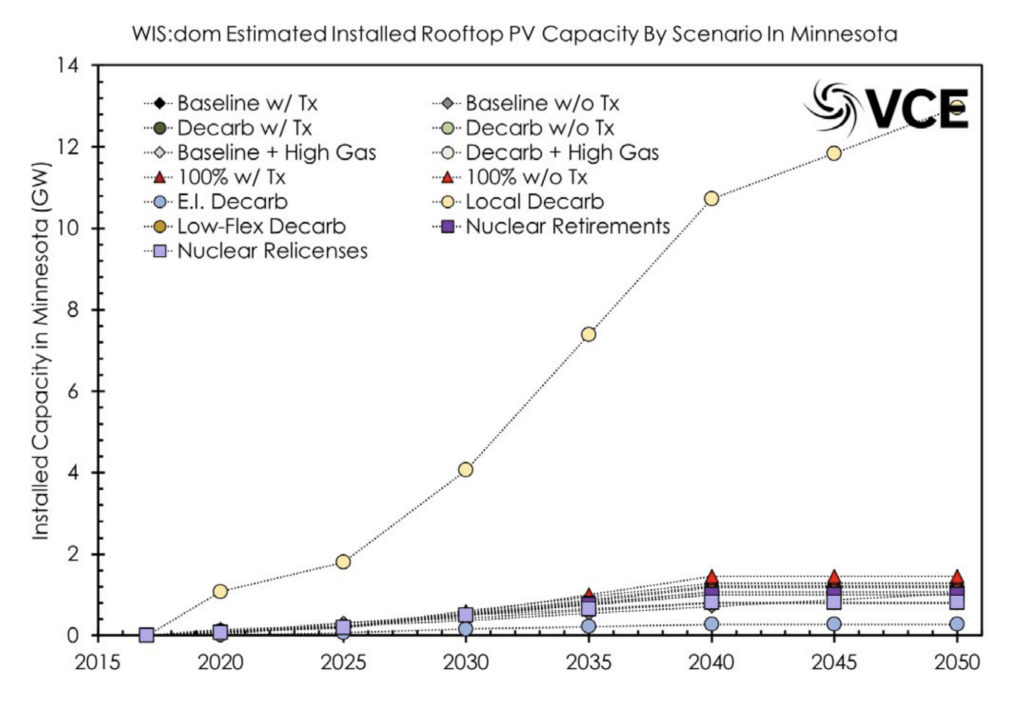
The second chart compares household energy savings for different decarbonization scenarios. The Local Decarbonization scenario, featuring 13 gigawatts of rooftop solar installed by 2050, provides close to the highest financial benefit. The dot representing the scenario, in yellow, is hidden just below the purple square of the Nuclear Retirements scenario, which showed the highest annual average savings for Minnesota households.
The Smarter Grid Study 13-Gigawatt Rooftop Solar Scenario Creates High Savings
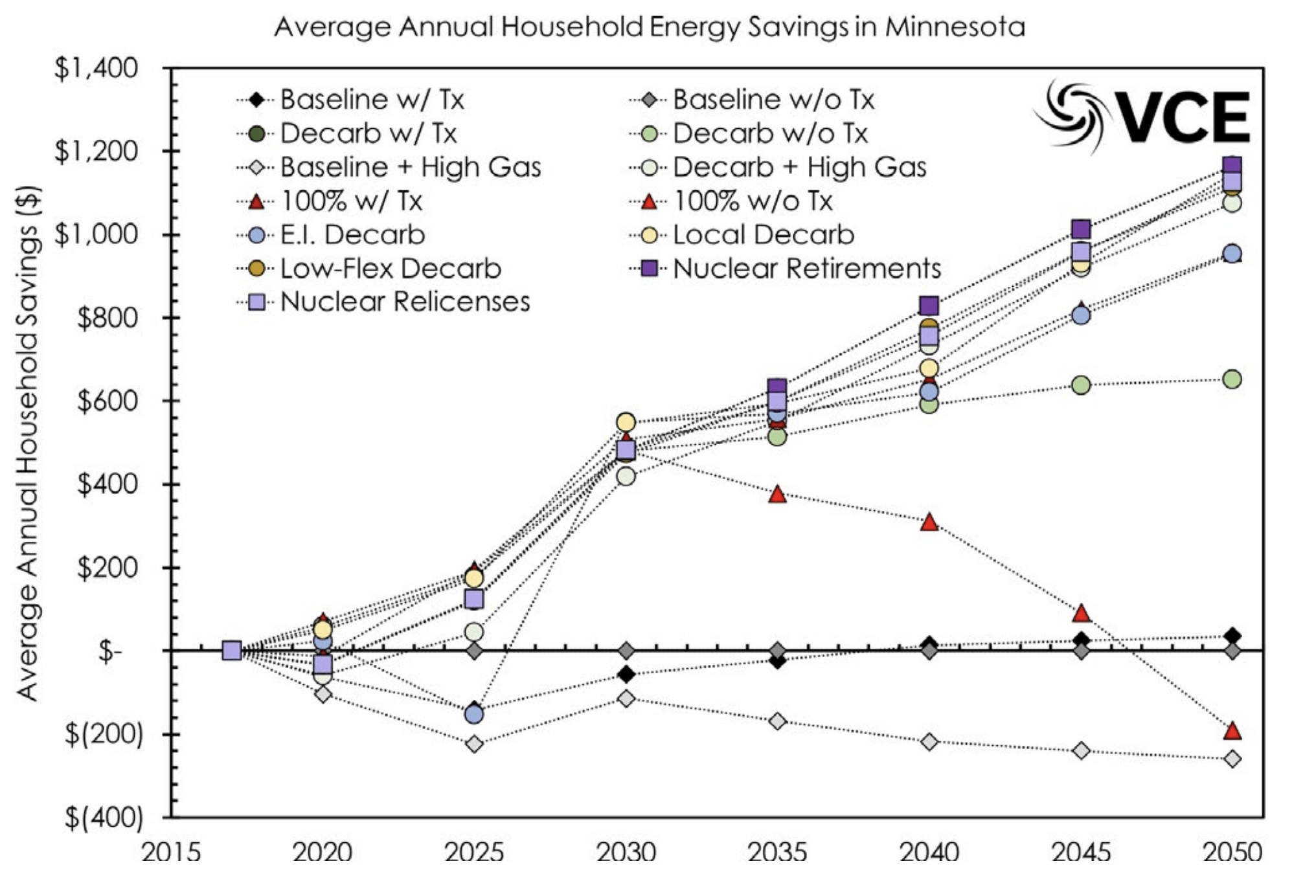
The final chart illustrates the job creation benefits of the differing scenarios, showing that the rooftop solar maximization scenario creates 40,000 jobs, more than any other scenario with comparably high levels of household energy savings.
The Smarter Grid Study 13-Gigawatt Rooftop Solar Scenario Creates 40,000+ Jobs
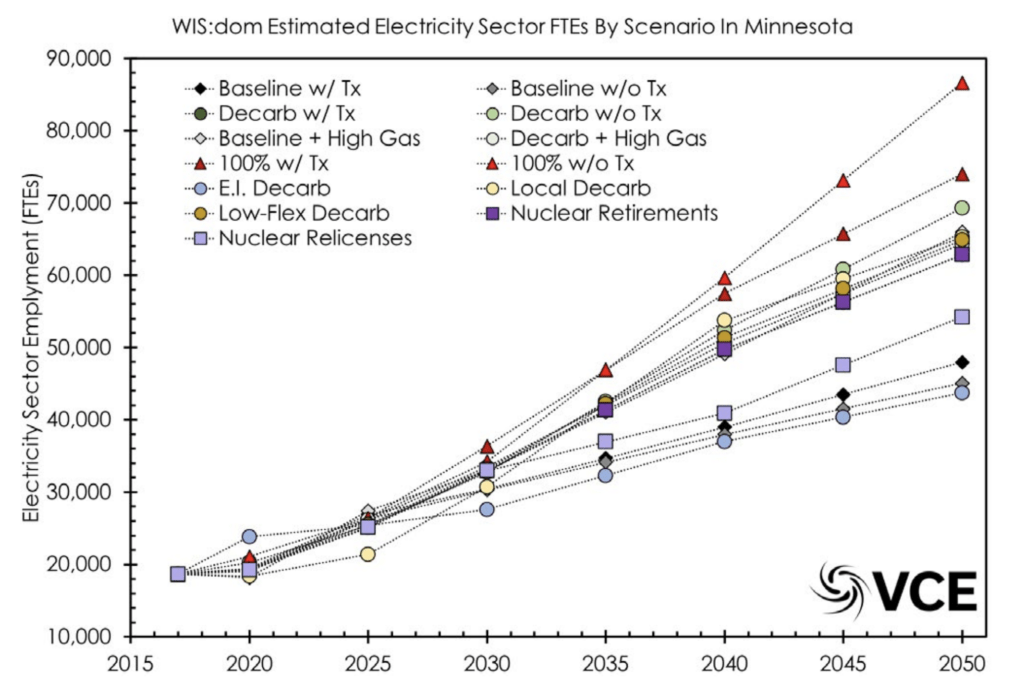
Utilities often ignore “local decarbonization” or rooftop solar scenarios in planning because they do not directly control deployment of these resources. Investor-owned utilities, in particular, may be reluctant to show state regulators scenarios that reduce the utility’s need to spend capital, its most reliable route to earning a profit. This means that public regulators have a responsibility to ensure that the resource plans of regulated utilities accurately reflect a careful analysis of the economic and financial benefits of power generation at any scale.
Community solar expands access
Community solar programs provide an opportunity to capture the economic and technical benefits of distributed energy and to provide access to solar energy to customers that do not own a sunny rooftop. While programs vary, a key characteristic is that customers can subscribe to energy production from a specific solar project (potentially nearby) and receive credit on their bill in proportion to their subscription.
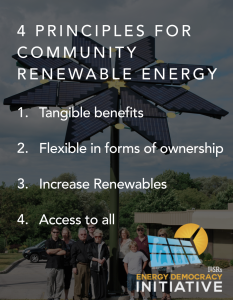
Community solar programs provide clean power for electricity grids, energy savings for customers, and opportunities for third parties to develop and own clean energy projects. The Institute for Local Self-Reliance’s Beyond Sharing report analyzes four key components of community solar programs: tangible benefits for customers, ownership options, increasing renewable energy, and offering access to all types of customers.
Most programs provide tangible benefits in the form of a bill credit. Some programs, like Maryland, treat community solar like virtual net metering and provide a bill credit similar to that offered to customers with on-site solar. Minnesota uses the value of solar, after having used a net metering proxy.
Most programs also provide ownership flexibility, requiring or allowing project ownership by subscribers or third parties. This important policy allows for projects like the Shiloh Temple community solar project in Minneapolis, a gold standard for community solar. The project, on a local church, recruited workers from the local population, was subscribed by the church and members of the congregation and neighborhood, and is cooperatively owned by subscribers.
Almost all community solar increases renewable energy deployment, but the best programs actually tie individual subscriptions to specific projects, giving customers certainty that their investment results in new clean energy development and a sense of connection to their energy source.
Access to all is the broadest and hardest policy objective to achieve. For one, it means that community solar should be available to all customer classes, not just residential customers. A big success of Minnesota’s program has been the opportunity for small and large commercial customers to participate. This didn’t encroach on residential participation for a key reason––Minnesota’s program has no capacity cap. Therefore, high participation from commercial customers doesn’t crowd out residential participation.
A second facet of access to all is allowing customers of any income or credit to participate. Few programs have succeeded on this measure. While Minnesota has no specific policy to increase access, the previously mentioned Shiloh Temple project has reached more low-income subscribers through an innovative “backup subscriber” model, where the church has agreed to pick up subscriptions if a customer moves or defaults on their payments. Other states have set minimum participation standards, special program phases, or other strategies to recruit low-income participants, but few have seen widespread success. Ensuring widespread access requires addressing several financial issues: inability to cover upfront costs, lack of credit to finance subscriptions, and what to do in the event the customer cannot continue their subscription.
While Minnesota’s program needs to do more to ensure widespread access, in the National Community Solar Tracker from the Institute for Local Self-Reliance, it continues to lead the nation in deployed community solar capacity.
The unique benefits of distributed energy
In the comparisons of large and small renewable energy, both share important characteristics of reduced health impacts from pollution, reducing fuel price risks, and providing price certainty. But distributed energy resources have unique values, reflected in numerous studies captured in this meta-analysis published in 2016. While many of these studies did not result in use of the valuation in active market policies, one state has been applying distributed solar valuations in solar markets for several years: Minnesota.
Conceived in legislation in 2013 and adopted in 2014, Minnesota’s value of solar policy captures the most common values used for distributed solar. Based on ILSR’s analysis, the following chart shows the value calculation for Xcel Energy customers from 2015 through 2020. For the past three years, the value of solar has been the contract price for new community solar projects in the state.
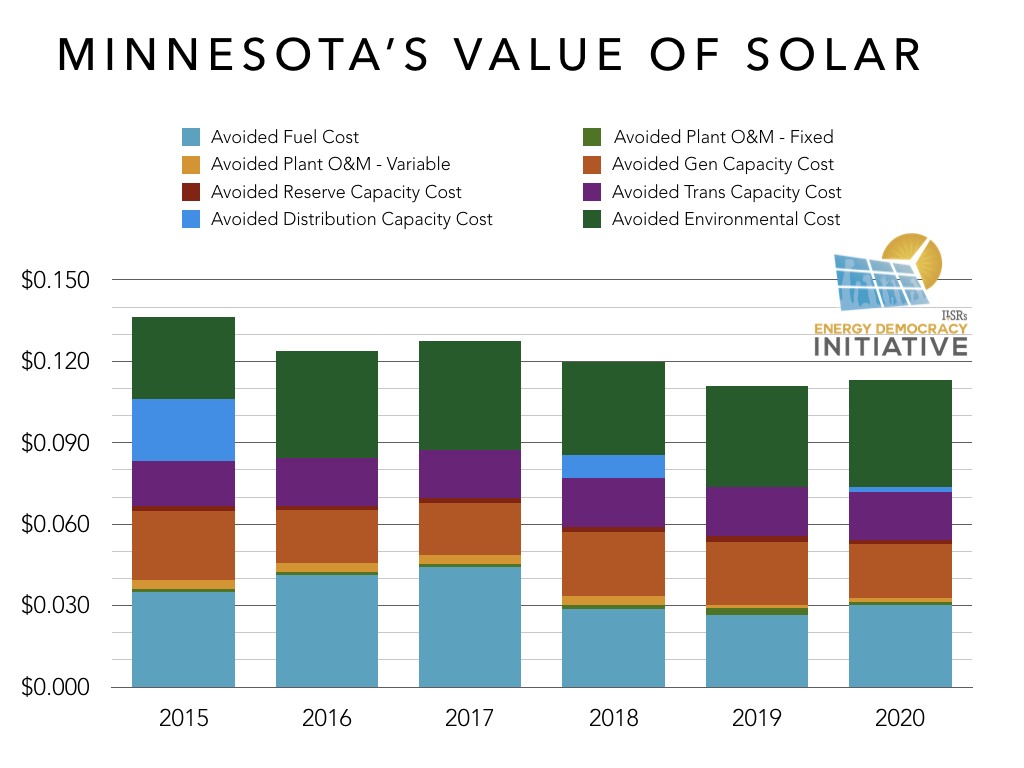
As the chart shows, avoided infrastructure costs have consistently been between $0.04 and $0.05 per kilowatt-hour. This reflects the unique value of distributed energy resources based on their interconnection point to the grid and proximity to load. It also represents the tension point between utility shareholders and customers, because it represents avoided utility capital spending (and profits) associated with otherwise needed transmission and distribution infrastructure. On-site distributed solar may have even higher avoided costs, because it interconnects even further from substations, behind the transformers serving just a few homes.
Minnesota’s landmark policy and its implementation provide a few lessons about the limitations of distributed solar valuation. For one, it still overlooks a number of important values, including resiliency, reliability, and job creation.
When paired with storage, for example, distributed solar can provide resilience to neighborhoods, communities, and cities that centralized power generation cannot. It can provide power to fire stations or hospitals, community cooling centers, or essential industries when grid power is unavailable due to natural disaster or public safety shutoffs.
Distributed solar can also enhance reliability. In the wake of the infamous 2003 black out affecting the northeast United States, one study found that 500 megawatts of distributed solar could have avoided the blackout by providing enough capacity and voltage support in key locations to prevent the blackout from cascading from one grid to another. Hundreds of megawatts of distributed energy resources on the PJM interconnection have since provided reactive power and voltage support to that region’s grid due to open markets with low thresholds for market entry (100 kilowatts). In regions without this market access, distributed energy resources have unrecognized value, and state regulators must fill the gap in the absence of market pricing by ensuring inclusion of distributed energy resources in resource modeling and planning.
Distributed solar also creates more jobs than centralized solar. As shown in the Minnesota Smarter Grid Study, similar levels of household energy savings and reduced carbon pollution are accompanied by thousands more jobs if the deployed capacity is built at small scale. In a 2018 report on distributed energy resources, the Institute for Local Self-Reliance found similar out-sized benefits from solar plus storage compared to the proposed Puente gas peaker plant in California. The summary table of the analysis is shown below.
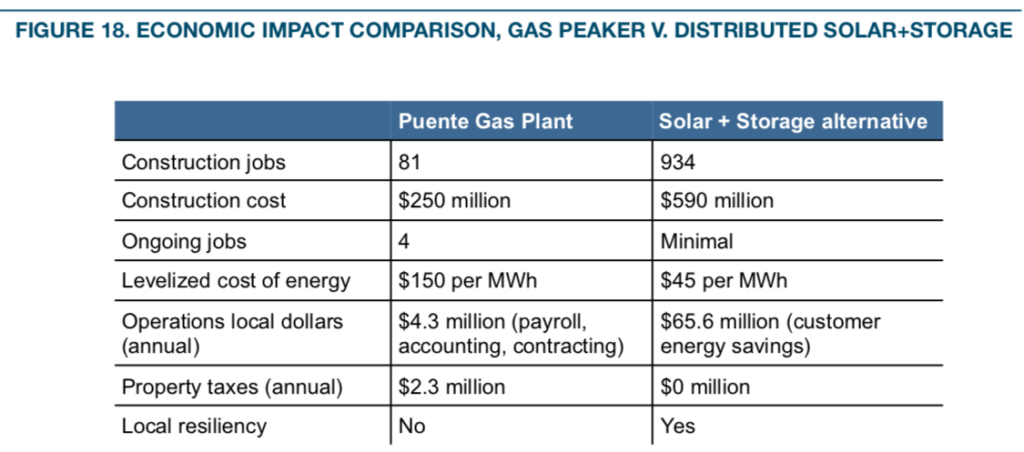
The proposed plant has since been scrapped, in lieu of renewable energy plus storage.
Minnesota’s value of solar may undervalue a number of important elements of distributed solar, but it also provides an important lesson about policy design. The Minnesota policy allows for a recalculation of solar valuation each year, but the revised values only apply to new projects. Existing projects lock in the solar valuation at the time of application approval, for 25 years. This balances value accuracy with a truth of solar development––to find financing for a solar project, developers need some certainty about their expected revenue. In New York, the value of distributed energy resources has resulted in a hyper-accurate and under-utilized market for distributed solar and other resources. In particular, the attempt to identify location specific values for solar, while admirable, has made development extremely uncertain. Minnesota’s policy strikes the balance between accuracy and usability.
The lesson from Minnesota for distributed solar locational value is particularly important. Many experts rightly assert that the locational value of distributed energy varies significantly, depending on the load and load profile of the distribution feeder, growth projections, substation age and capacity, and actions of other customers on the same feeder. Minnesota’s policy includes the option of a locational component, but stakeholders have already spent more than a year trying to identify the right principles and procedures to provide both accuracy and certainty. Part of the problem is that few utilities collect the feeder-level data necessary to do accurate valuation. Xcel Energy’s hosting capacity analysis, for example, relies on some data collected by automated SCADA systems and other data collected manually. Until the most recent filing, the estimates of available capacity on the utility’s feeders did not even include projects in the interconnection queue, essential data for valuing prospective new distributed solar systems. And even if the utility and regulators develop an accurate picture of locational value, if it varies too much from year to year, it may not be possible to use it to guide new projects when developers need revenue certainty to obtain project financing.
Grid planning: The big picture
A final important consideration in distributed energy development is the underlying assumption that it represents an exception to the “appropriate” model of grid planning. Integrated resource planning was proposed in response to spectacular financial disasters related to large, centralized power plant development in the 1960s and 1970s. The planning presumption was that more oversight would address the shortcomings of utility planning even if it didn’t change the paradigm of large, central-station power generation. At the time, there was little practical experience with alternative business models. That is no longer true.
For example, in the past decade, California electricity customers have cumulatively deployed 6 gigawatts of power generation capacity without an approved resource plan. The following graphic illustrates where the solar was built by quarter, but, more importantly, it illustrates how the widespread availability of distributed energy undercuts the presumptive value of top-down resource planning.
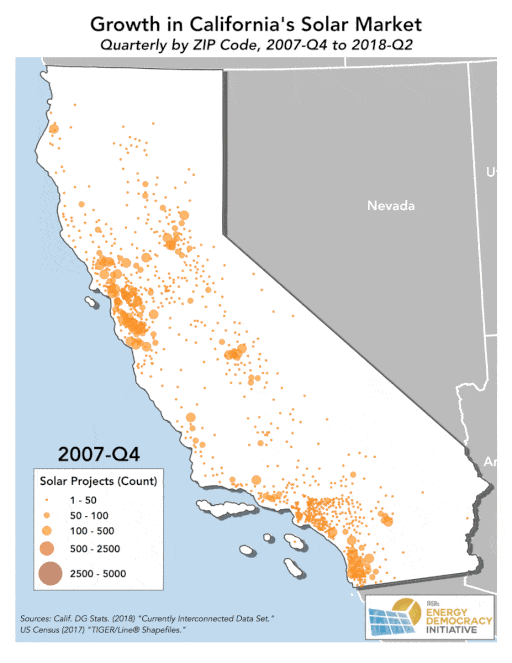
Electric utilities often focus on the marginal costs of customer-owned generation, a perspective that is uniquely applied to these resources. In contrast, when electricity demand grew in the early years of the grid, costs of service––interconnection and power generation––were socialized to allow electricity service to expand broadly. The social compact worked perfectly because utility shareholders were happy to deploy capital to address customer demands and power costs kept falling relative to inflation. California’s customers have sent a clear message to utilities and regulators: we will not rely solely on a monopoly utility market to provide power. This message is a “postcard from the future” for states with less intense sunlight and lower retail electricity prices, but the delivery is imminent.
The implication for other states is significant, because it suggests that the marginal costs in resource planning are the centralized, utility-scale ones, not the distributed ones. In other words, good public utilities should design their grid to maximize these customer-capitalized resources. It will be up to public regulators to square the circle of aligning utility financial incentives with a market that no longer demands similarly high deployment of utility capital.
This article originally posted at ilsr.org. For timely updates, follow John Farrell on Twitter, our energy work on Facebook, or sign up to get the Energy Democracy weekly update.
Photo Credit: Consumers Energy via Flickr (CC BY-NC-ND 2.0)

